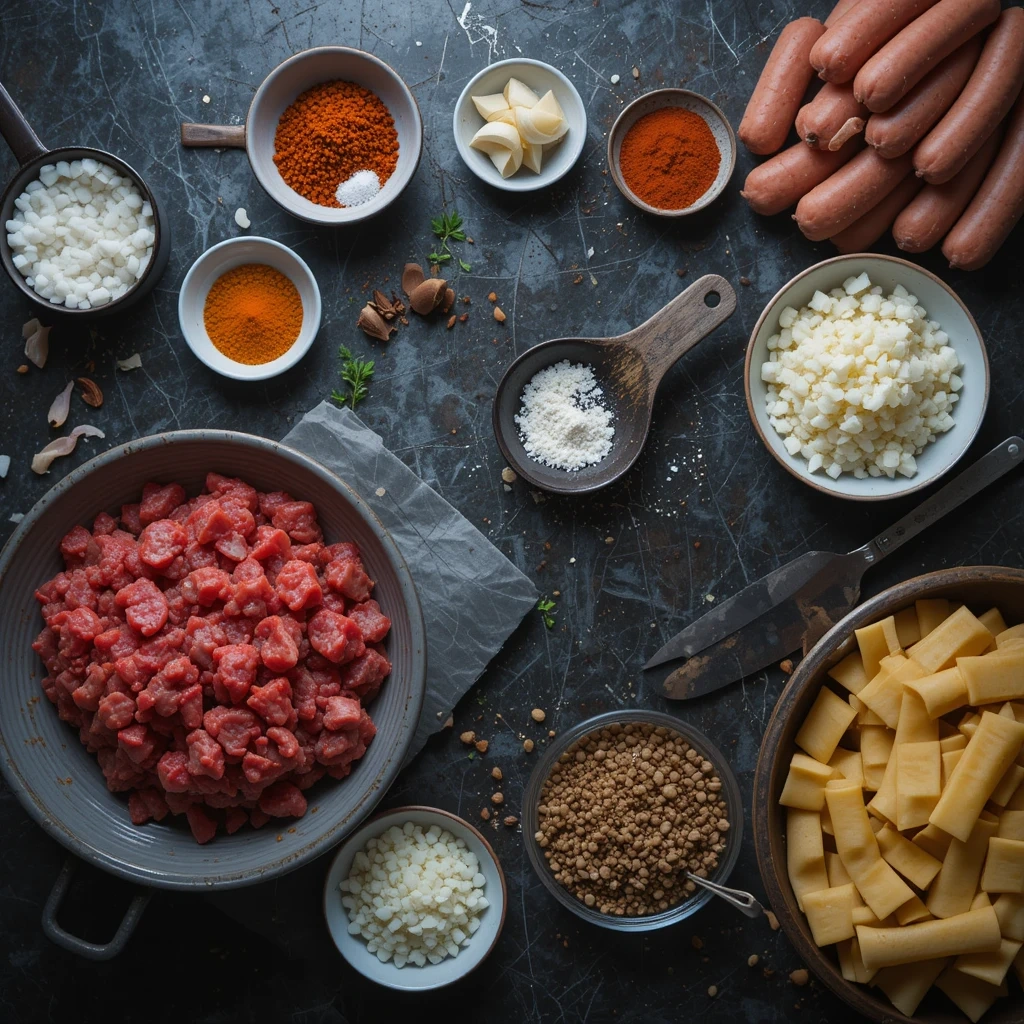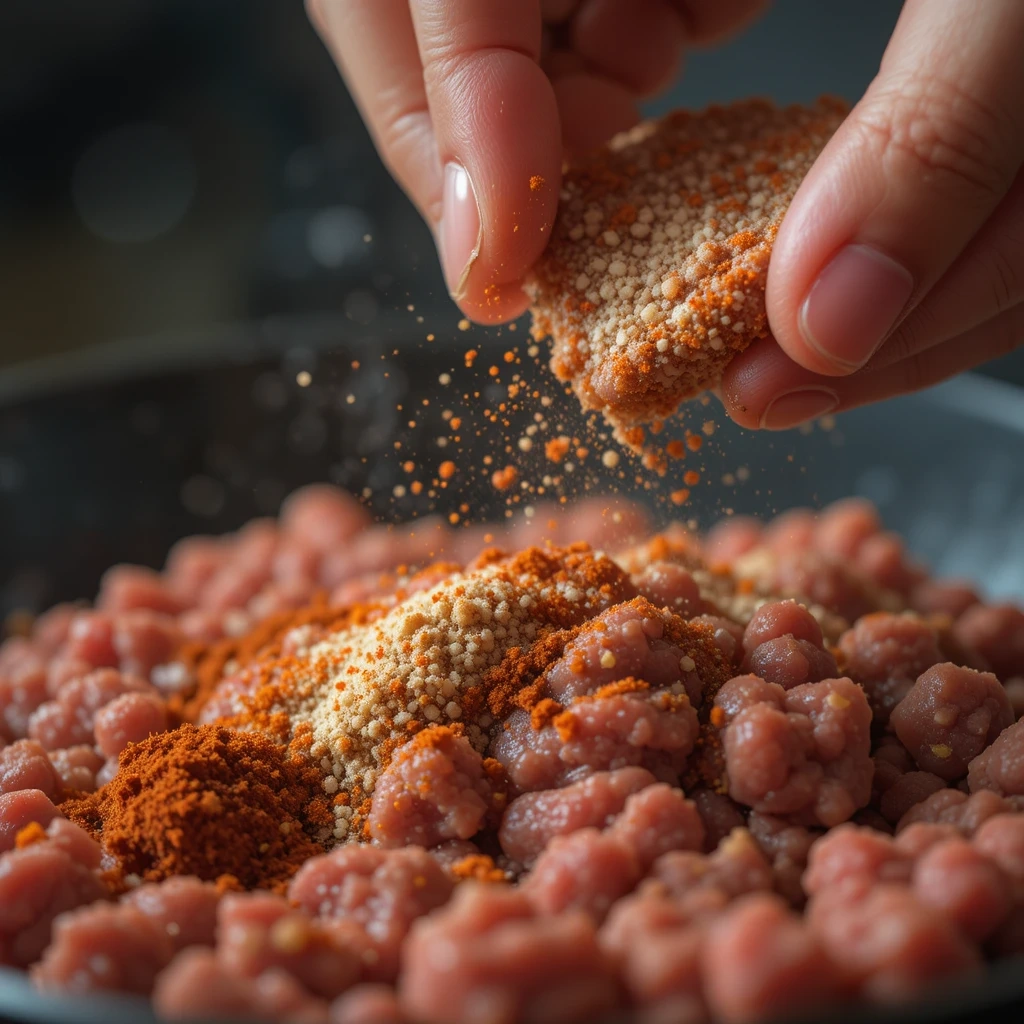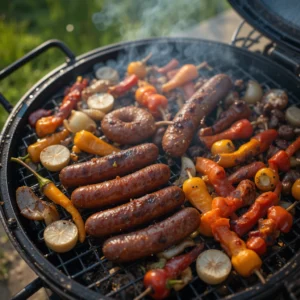Selecting the right type of beef sausage is the first step in cooking perfect beef sausage at home. With various options available, each sausage has a unique flavor profile and texture. High-quality beef, like grass-fed, can significantly enhance the flavor. Proper preparation of ingredients, such as chopping vegetables and toasting spices, can elevate the dish. Experimenting with seasonings like smoked paprika or brown sugar can transform the sausage’s taste. Different cooking methods, including grilling, baking, and pan-frying, offer versatility. Avoiding common mistakes like overcooking and ensuring proper resting time are crucial for achieving juicy and flavorful beef sausage.
When it comes to cooking perfect beef sausage at home, the first step is selecting the right type of sausage. I remember the first time I ventured into the world of homemade sausages; I was overwhelmed by the variety available at my local butcher. From spicy Italian to smoky bratwurst, each type has its unique flavor profile and texture.
I learned that not all beef sausages are created equal, and choosing one that suits your taste preferences is crucial. For instance, if you enjoy a bit of heat, a spicy beef sausage might be your best bet, while those who prefer milder flavors might opt for a classic beef sausage. Another important factor to consider is the quality of the meat.
I’ve found that sourcing high-quality beef from a reputable butcher can make a world of difference in the final product. Grass-fed beef, for example, tends to have a richer flavor and better texture than conventional options. When I first tried using grass-fed beef for my sausages, I was amazed at how much more flavorful they turned out.
So, take your time to explore different options and don’t hesitate to ask your butcher for recommendations based on your cooking plans.
Table of Contents
Preparing the Ingredients
Once you’ve chosen your beef sausage, it’s time to prepare the ingredients. This step is often overlooked, but I’ve learned that proper preparation can elevate your dish significantly. Start by gathering all your ingredients, including any additional spices or vegetables you want to incorporate.
I remember one time when I decided to add caramelized onions and garlic to my beef sausage mix. The aroma that filled my kitchen was nothing short of heavenly, and it added a depth of flavor that took my sausages to the next level. Chopping and measuring your ingredients ahead of time can save you from last-minute chaos in the kitchen.
I often find it helpful to lay everything out on my countertop before I start cooking. This way, I can easily grab what I need without fumbling around. Additionally, if you’re planning to add herbs or spices, consider toasting them lightly in a pan before mixing them into your sausage.
This simple technique enhances their flavors and makes a noticeable difference in the final taste.

Seasoning and Flavoring the Sausage
Seasoning is where the magic happens when it comes to beef sausage. I’ve experimented with various combinations over the years, and I can confidently say that the right blend of spices can transform an ordinary sausage into something extraordinary. A basic mix might include salt, pepper, and garlic powder, but don’t be afraid to get creative!
One of my favorite blends includes smoked paprika and crushed red pepper flakes for a smoky kick. The first time I tried this combination, my friends couldn’t stop raving about how delicious the sausages were. It’s also essential to balance flavors when seasoning your sausage.
I’ve learned that adding a touch of sweetness can complement the savory notes beautifully. For instance, incorporating a bit of brown sugar or honey can enhance the overall flavor profile without making it overly sweet. As you mix your seasonings into the meat, don’t forget to taste as you go.
This practice not only helps you adjust flavors but also builds your confidence in seasoning.

Cooking Methods for Beef Sausage
| Cooking Method | Temperature | Time |
|---|---|---|
| Grilling | Medium-High | 10-12 minutes |
| Pan-Frying | Medium | 8-10 minutes |
| Baking | 350°F (175°C) | 20-25 minutes |
| Boiling | Simmering | 10-12 minutes |
There are several methods for cooking beef sausage, each offering its unique benefits and flavors. Personally, I love experimenting with different techniques depending on my mood and the occasion. Grilling is one of my go-to methods during summer barbecues.
The smoky flavor from the grill adds an irresistible char that elevates the sausages. I remember hosting a backyard party where I grilled sausages alongside peppers and onions; the combination was a hit among my guests. Another method I enjoy is baking beef sausage in the oven.
It’s a hands-off approach that allows me to focus on preparing side dishes or enjoying time with family while they cook. When baking, I usually place the sausages on a wire rack over a baking sheet to allow for even cooking and crispiness. The first time I tried this method, I was pleasantly surprised by how juicy and flavorful the sausages turned out without much effort on my part.

Tips for Grilling Beef Sausage
Grilling beef sausage can be an art form in itself, and over time, I’ve picked up some valuable tips that have made my grilling experience much more enjoyable. One crucial tip is to preheat your grill properly before placing the sausages on it. This ensures that they cook evenly and develop those beautiful grill marks we all love.
I remember one summer evening when I was too eager to start grilling and placed the sausages on too soon; they ended up sticking to the grates and tearing apart. Another important aspect is to avoid piercing the sausages while grilling. It’s tempting to poke them with a fork to check for doneness, but this can cause all those delicious juices to escape.
Instead, I’ve learned to use tongs for flipping them gently. A good rule of thumb is to grill them over medium heat for about 12-15 minutes, turning occasionally until they reach an internal temperature of 160°F. This way, you’ll have perfectly cooked sausages that are juicy and bursting with flavor.
Baking Beef Sausage in the Oven
Baking beef sausage in the oven is an excellent alternative when grilling isn’t an option or when you want a more hands-off approach. Preheating your oven to 400°F creates an ideal environment for cooking sausages evenly while allowing them to crisp up nicely on the outside. I often line a baking sheet with parchment paper for easy cleanup, which has saved me countless hours scrubbing pans after cooking.
One of my favorite things about baking sausages is that you can easily add vegetables to the mix. For instance, tossing some sliced bell peppers and onions onto the baking sheet alongside the sausages creates a complete meal in one go. The first time I tried this method, I was amazed at how well everything cooked together; the flavors melded beautifully, and it made for a colorful presentation on my dinner table.
Pan-Frying Beef Sausage
Pan-frying beef sausage is another fantastic method that yields delicious results with minimal effort. Using a cast-iron skillet is my preferred choice because it retains heat well and gives a lovely sear to the sausages. When pan-frying, I usually add a splash of oil to prevent sticking and enhance browning.
One memorable evening, I decided to whip up some pan-fried sausages with sautéed mushrooms and spinach; it turned out to be a delightful combination that left everyone asking for seconds. Timing is key when pan-frying; I typically cook them over medium heat for about 10-12 minutes, turning occasionally until they’re golden brown and cooked through. The fragrance that envelops your kitchen as you go through this is utterly enchanting!
Plus, pan-frying allows for easy customization; you can throw in some garlic or herbs during the last few minutes of cooking for an extra flavor boost.
5 Common Mistakes to Avoid and Their Solutions
As with any cooking endeavor, there are common pitfalls when preparing beef sausage at home that I’ve encountered along my culinary journey. One mistake I’ve made is not allowing the sausages to come to room temperature before cooking them. This could cause the food to cook unevenly and become dry.
To avoid this, simply take them out of the fridge about 30 minutes before you plan to cook them; this small step makes a significant difference in texture. A frequent mistake is putting too many sausages in the pan or on the grill at once. In my early days of cooking, I often tried to cook too many at once, which resulted in steaming rather than browning.
To remedy this, I now cook in batches, giving each sausage enough space to develop that beautiful crust we all crave. A third mistake I’ve made is not checking for doneness properly; relying solely on time can be misleading. Investing in a meat thermometer has been a game-changer for me; it ensures that my sausages are cooked perfectly every time without guesswork.
Additionally, seasoning too late in the process can lead to bland sausages. I’ve learned that incorporating spices early on allows their flavors to meld beautifully with the meat. Lastly, forgetting about resting time after cooking can lead to dry sausages as well; letting them rest for a few minutes allows juices to redistribute throughout the meat.
By avoiding these common mistakes and following these steps, you’ll be well on your way to mastering the art of cooking perfect beef sausage at home!
FAQs
What is the best way to choose the right beef sausage for cooking at home?
When preparing the ingredients for beef sausage, what should I keep in mind?
How can I season and flavor beef sausage to enhance its taste?
What are the different cooking methods for beef sausage?
What are some tips for grilling beef sausage to perfection?
How can I bake beef sausage in the oven for a delicious outcome?
What is the best way to pan-fry beef sausage for a crispy texture?
What are some common mistakes to avoid when cooking beef sausage at home?
What are the solutions to the common mistakes made when cooking beef sausage?

beef sausage
Ingredients
- 1 pound beef sausage”
- “Salt to taste”
- “Pepper to taste”
- “1 teaspoon garlic powder”
- “1 teaspoon smoked paprika”
- “1/2 teaspoon crushed red pepper flakes optional”,
- “1 tablespoon brown sugar or honey optional”,
- “Vegetable oil for pan-frying”
- “Bell peppers optional”,
- “Onions optional”,
- “Sausage buns optional”,
- “Additional spices to taste”
- “Pros”: [
- “Versatile cooking methods grilling, baking, pan-frying”,
- “Easy to customize with different seasonings”
- “Can be paired with various side dishes”
- “Great for summer barbecues or quick weeknight meals”
- “High-quality beef provides rich flavor and texture”
- “Cons”: [
- “Overcooking can result in dry sausages”
- “High heat can cause uneven cooking”
- “Improper seasoning can lead to bland flavor”
- “Not allowing sausages to rest can cause loss of juices”
- “Piercing sausages during cooking can lead to loss of juices”
Instructions
- “Choose high-quality beef sausage with the desired flavor profile (e.g., spicy, mild).”,
- “Gather all ingredients, including additional spices and vegetables.”,
- “If adding vegetables, chop them ahead of time.”,
- “Consider toasting herbs or spices lightly to enhance their flavors.”,
- “In a bowl, mix the ground beef with salt, pepper, garlic powder, smoked paprika, and crushed red pepper flakes (if using).”,
- “Add brown sugar or honey for a touch of sweetness (if desired).”,
- “Taste the mixture and adjust seasonings as needed.”,
- “Choose your preferred cooking method:”,
- “Grilling: Preheat grill to medium-high heat. Grill sausages for 10-12 minutes, turning occasionally, until they reach an internal temperature of 160°F.”,
- “Baking: Preheat oven to 350°F (175°C). Place sausages on a wire rack over a baking sheet. Bake for 20-25 minutes, until cooked through.”,
- “Pan-Frying: Heat a splash of oil in a cast-iron skillet over medium heat. Add sausages and cook for 8-10 minutes, turning occasionally, until golden brown and cooked through.”,
- “Boiling: Place sausages in a pot and cover with water. Bring to a boil, then reduce heat and simmer for 10-12 minutes.”,
- “Avoid piercing the sausages while cooking to retain juices.”,
- “Use tongs for flipping them gently.”,
- “Cook in batches to avoid overcrowding the pan or grill.”,
- “Check for doneness using a meat thermometer.”,
- “Allow the sausages to rest for a few minutes after cooking to redistribute juices.”,
- “Serve hot on buns with your favorite toppings or alongside side dishes.”

